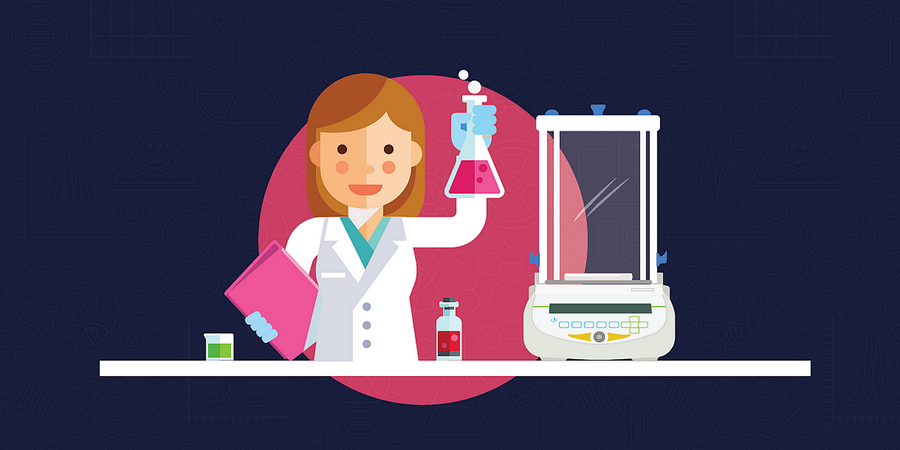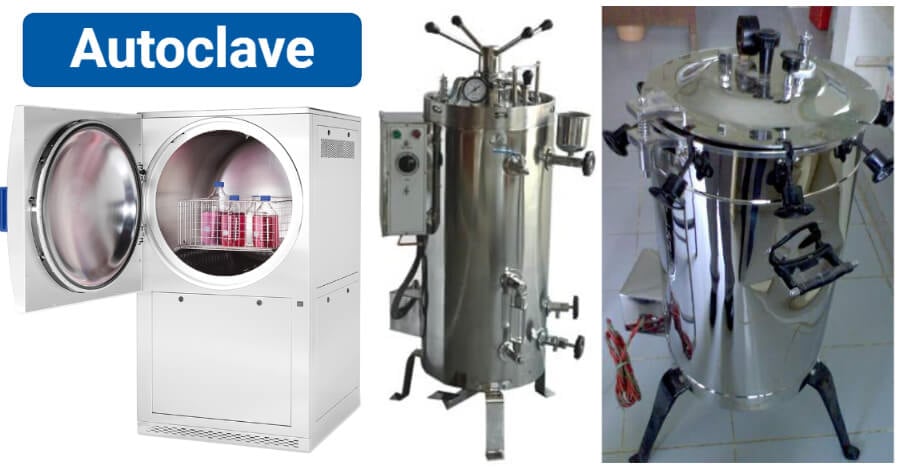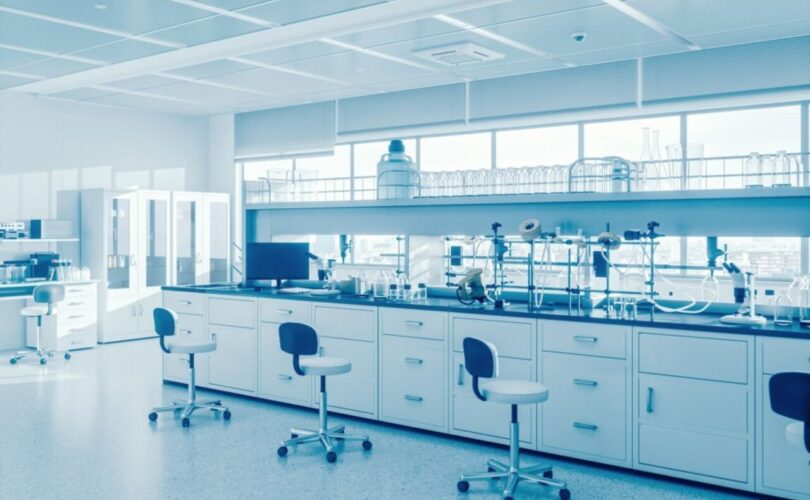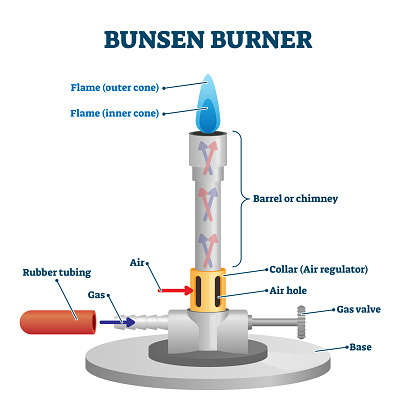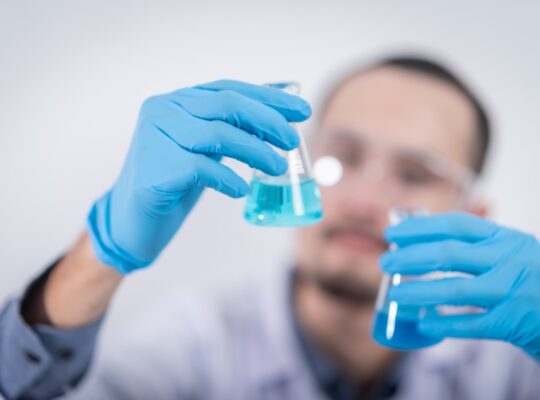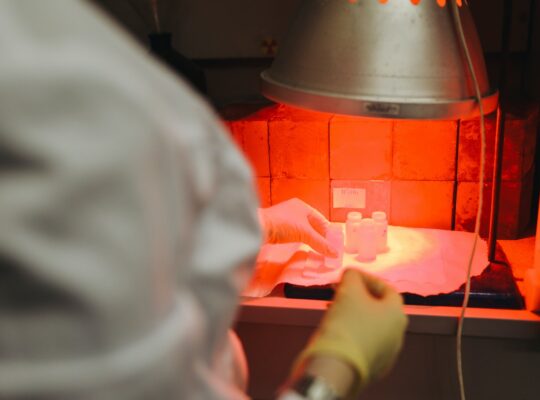A centrifuge is a device that allows the rotation of an object about a single axis, where an outward force is applied perpendicularly to the axis. A laboratory centrifuge is motor-based and allows the rotation of a liquid sample resulting in the separation of the components of the mixture.
A centrifuge works on the principle of sedimentation, where the high speed of the rotation causes the denser particles to move away from the center while smaller, less dense particles are forced towards the center.
Thus, the denser particles settle at the bottom while the lighter particles are collected at the top.
In a laboratory tabletop centrifuge, the sample tubes are aligned at an angle so that the particles have to travel a shorter distance before they hit the bottom.
The primary application of a centrifuge is the separation of particles suspended in a suspension. It can be used for the separation of cell organelles, nucleic acid, blood components, and separation of isotopes.
A colony counter is used to estimate the density of a liquid culture by counting the number of CFU (colony forming units) on an agar or culture plates.
This instrument can accommodate different sizes of plates which are scanned on top with UV, white light and/or fluorescent illumination.
One can accomplish the counting either manually with the touch pressure or with a digital counter.
A colony counter is primarily used for counting the number of colonies present on a culture plate to estimate the concentration of microorganisms in liquid culture.
Deep freezers are based on the principle that under extremely low temperatures, there is minimum microbial growth which allows for the protection and preservation of different substances.
Based on this principle, we can even preserve cultures over a long period of time without any change in the concentration of the microorganisms.
A deep freeze can be used for the preservation of different things used in the laboratories for a very long period of time. Deep freezers are used in laboratories to store and preserve medical equipment, food items, blood samples, medicines, and injections, etc. for a more extended period of time.
Homogenizer is a device used in laboratories for the mixing of various liquids and materials like tissue, plant, food, soil, and many others.
This instrument is based on the principle that when large globules in coarse emulsion are passed under high pressure through a narrow orifice, they break down into smaller particles giving a more uniform and stable mixture.
A homogenizer has a metal rod with narrow parallel openings in the form of a comb at the end which acts as the orifice for the homogenization process.
A homogenizer is primarily used to disrupt cells to acquire cell organelles for different microbiological processes.
It is used in the preparation step before the extraction and purification of different macromolecules like proteins, nucleic acids, and lipids.
A hot plate is a stand-alone appliance used in microbiology laboratories as a tabletop heating system.
Unlike the traditional ways of producing heat through fire, a hot plate produces heat by the flow of electricity.
On a hot plate, electricity runs through the coils which have a high level of electrical resistance. The resistance in the coils converts the electrical energy into heat energy which causes the coils to release heat.
In a laboratory, hot plates are used to heat glassware and its components.
They are used over water baths as water baths might be hazardous in case of any spills or overheating.
A hot air oven is an electrical device that is used for sterilization of medical equipment or samples using dry heat.
A hot air oven is a type of dry heat sterilization which is performed on dry materials and on substances that do not melt or catch fire under high temperatures.
There are two types of hot air ovens based on the working principle
Forced air hot air oven: In this type of hot air oven, the heated air inside the oven is distributed throughout the oven with a fan. This prevents the rising of hot air towards the top while keeping the cold air at the bottom. This allows for the adequate heating of materials inside the oven.
Static air hot air oven: In this type of oven, the heat is produced by coils present at the bottom of the oven with no fan. The hot air rises and doesn’t allow the effective sterilization of the materials.
The equipment inside the oven acquires heat and passes the heat towards the center, one layer at a time which allows for effective dry heat sterilization.
A hot air oven can be used to sterilize materials like glassware, metal equipment, powders, etc.
It allows for the destruction of microorganisms as well as bacterial spores.
An incubator is a device that is used in laboratories for the growth and maintenance of microorganisms and cultures. Incubator provides an optimal temperature, pressure, moisture, among other things required for the growth of microorganisms.
The incubator is based on the principle of maintaining a proper atmosphere for the growth of microorganisms.
Incubators have a heating system that allows for the temperature within the incubator to be adjusted according to the type of organism cultivated inside.
Similarly, they are provided with adjustments for maintaining the concentration of CO2 to balance the pH and humidity required for the growth of the organisms.
Variation of the incubator like a shaking incubator is also available, which allows for the continuous movement of the culture required for cell aeration and solubility studies.
Incubators have a wide range of applications including cell culture, pharmaceutical studies, hematological studies, and biochemical studies.
Incubators can also be used in the steam cell research area.
Laminar Hood is a closed device primarily for processes or instruments sensitive to microbial contamination.
A Laminar Hood is made up of stainless steel, avoiding joints and corners to prevent the accumulation of bacterial spores.
This device creates a sterile environment with the flow of sterile air through a High-Efficiency Particulate Air (HEPA) filter and shortwave ultraviolet germicidal lamp that sterilizes the workstation.
Laminar Air Flow has to turn on 15 minutes before to ensure complete sterilization and the workstation should be cleaned with ethanol before and after use.
Laminar Hood is commonly used to conduct processes that are sensitive to contamination.
It is used for experiments related to plant tissue culture and for the experiments of genetic transformation.
Magnetic Stirrer is a device commonly used in microbiology laboratories for the purpose of mixing liquids.
This device consists of a rotating magnetic or an electromagnet creating a rotating magnetic field that allows the stir bar (a piece of heavy metal) to move around in the vessel.
It is coupled with a heating system to heat the liquid while it is mixed.
It is usually used for mixing various liquid components in a mixture in a chemical or microbiology laboratory.
This device is used in place of other stirrers as it is noise-free and because the size of the stir bar is so tiny, there is less chance of contamination.
Microscopes are devices that allow the observer to have an exceedingly close view of minute particles.
There are many different types of microscopes, each of which works on its respective principles. However, there is some commonality in them.
The basic principle in a microscope is magnification. Based on the relative position of the object from the lens or electromagnets, different positions, nature, and magnification of the image can be achieved.
Different types of microscopes are developed to cater to the specific needs of the observation. However, the common theme is magnification.
Based on the type of microscopes, different microscopes are used for different purposes.
They are primarily used for the observation of minute particles which cannot be observed with naked eyes.
A pH meter is a device used in laboratories that measure the H-ion concentration in water-based solutions to determine the acidity or alkalinity of the solution. A pH meter is often termed a “potentiometric pH meter” as it measures the difference in electric potential between the reference and a pH electrode.
In a potentiometric pH meter, single or multiple glass electrodes, connected to a bulb selective to hydrogen ions, are attached to a metal rod.
When the bulb with the electrodes is dipped into a solution, hydrogen ions in the solution exchange with positive charges on the electrode generating an electrochemical potential which is displayed in terms of pH units on display.
A pH meter is primarily used to measure the acidity of pharmaceutical chemicals, cultures, soil, and water treatment plant.
It can be used to measure the acidity level in wine and cheese during their production.
The spectrophotometer is an optical instrument for measuring the intensity of light in relation to wavelength. Based on the amount of light absorbed by a colored solution, a quantitative analysis of the solution can be done.
Spectrophotometry is based on the Beer-Lambert Law, which states the absorbance of light by a solution (of a particular wavelength) is directly proportional to the concentration of the substance.
Different wavelengths of light are passed through a solution as different substances have better absorbance at different wavelengths. Based on the absorbance of a particular wavelength, the quantitative analysis of a solution can be done.
In a microbiology laboratory, a spectrophotometer is applied for the measurement of the substance concentration of protein, nucleic acids, bacterial growth, and enzymatic reactions.
A vortex mixture is one of the basic technologies used for the mixing of samples in glass tubes or flasks in laboratories.
It is based on the simple principle of causing reactions and homogenization by agitating the mixture.
Motorized draft shafts present on the mixer oscillate and transfer the movement to the sample tubes causing the sample fluids to undergo turbulent flow.
Vortex mixer is mostly used for the mixing of various sample fluids in the sample tubes and also allows for the homogenization of cells and cell organelles.
Water Bath is a conventional device that is used for chemical reactions that required a controlled environment at a constant temperature.
A sensor in the device transfers water temperature to a reference value which is then amplified and a control system generates a signal for the heating system which heats the water to the desired temperature.
Water baths are primarily used for heating samples under a controlled temperature.
These are suitable for heating chemicals that might be flammable under direct ignition.
A water distiller is a device that purifies water by the process of distillation. This instrument is commonly used in medical laboratories, microbiology laboratories, organic chemistry laboratories, and medical industries.
A water distiller is based on the principle of distillation.
According to this process, water is first brought to a boil and then condensed into liquid form to obtain pure distilled water.
It is used to obtain distilled water required for many lab tests as well as for the preparation of culture media.
https://www.adamequipment.com/aeblog/
https://pharmawiki.in/autoclave-sterilization-principle-working-pdf-ppt-
https://www.britannica.com/science/Bunsen-burner
https://www.biocompare.com/Lab-Automation-High-Throughput/11357-Colony-Counters/
https://www.prestogroup.com/articles/deep-freezers-for-medical-laboratories/
https://www.britannica.com/technology/pH-meter
https://www.glascol.com/what-is-vortex-mixer
https://labrotovap.com/working-principle-of-water-bath/
https://pharmawiki.in/pdf-ppt-hot-air-oven-working-principle-sterilization-
https://www.labmanager.com/product-focus/incubators-20299
https://www.orchideenvermehrung.
Source Link
VIDEO
